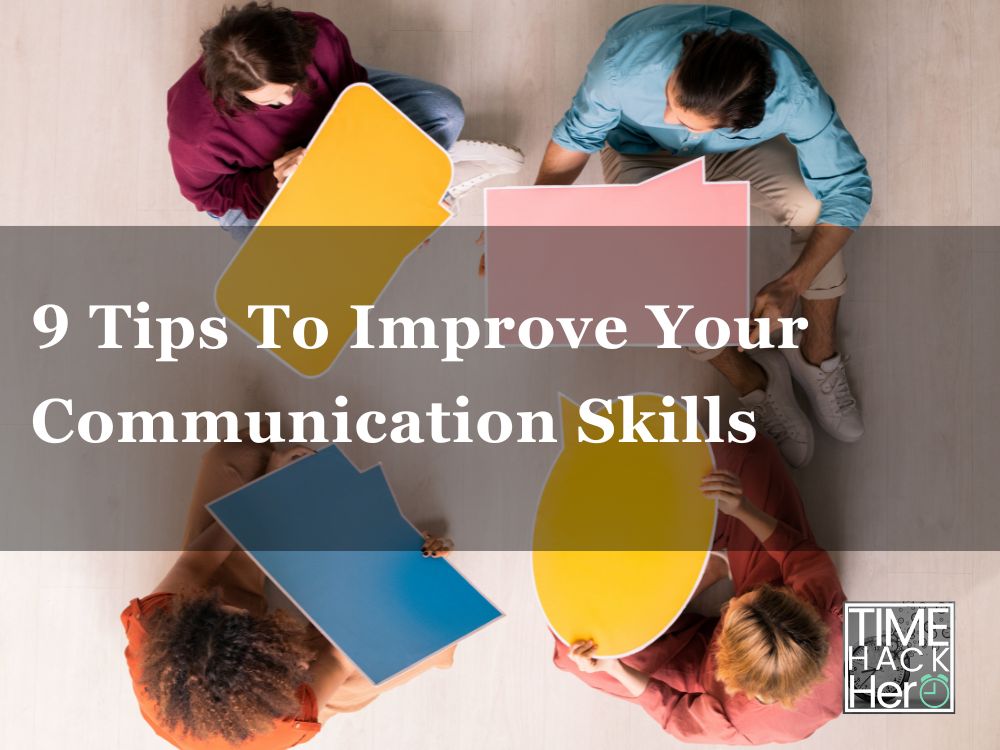Effective communication is an essential life skill. The way we share information and express ourselves impacts our relationships, careers, education, and overall wellbeing. Strong communication skills allow us to clearly convey ideas, listen attentively, provide constructive feedback, resolve conflicts, and connect with others on a deeper level. While communication comes more naturally to some, anyone can improve this skill with deliberate effort.
This comprehensive guide outlines practical tips and strategies to enhance communication abilities in both personal and professional contexts. Mastering these techniques leads to more meaningful connections, fruitful collaborations, professional success, and satisfying relationships.
Table of Contents
Understand the Components of Communication
Communication is a complex process that involves multiple elements. By breaking it down into smaller parts, we can pinpoint areas to target for improvement.
Sender
The sender initiates communication by encoding a message and transmitting it to another party. This involves transforming thoughts and ideas into a format the receiver can interpret, such as speech, writing, gestures, or artistic expression.
To become a better sender:
- Carefully consider your objective – What is the purpose of the message? What do you hope to accomplish?
- Organize your thoughts before communicating. Outline key points.
- Use language suited to the receiver’s knowledge, attitudes, and social context.
- Check for clarity. Could the message be misunderstood?
Message
The message conveys meaning through verbal and nonverbal cues. Verbal cues include spoken or written words. Nonverbal signals like facial expressions, tone of voice, gestures, and body language provide additional context.
To craft better messages:
- Express information clearly, concisely, and logically.
- Limit jargon and explain unfamiliar terms.
- Reinforce key points with nonverbal signals.
- Use positive language. Avoid hostility or aggression.
Channel
The channel is the method used to convey the message. Common channels include face-to-face conversation, phone calls, video conferencing, emails, reports, speeches, and social media.
When selecting a channel:
- Consider the message’s complexity. In-person channels allow for feedback and clarification of nuanced topics.
- Match the channel to the receiver’s preferences and context.
- For sensitive issues, choose a private channel less prone to misinterpretation.
Receiver
The receiver decodes the sender’s verbal and nonverbal cues to derive meaning. This involves actively listening, interpreting tones and facial expressions, and asking clarifying questions.
To become a better receiver:
- Eliminate distractions and focus fully on the message.
- Avoid interrupting. Let the sender finish before responding.
- Paraphrase the message to check understanding.
- Observe nonverbal signals and consider their implications.
- Ask questions to clarify ambiguous points.
Feedback
Feedback allows the receiver to respond and confirm if the message was accurately conveyed and understood. Positive feedback indicates comprehension while negative feedback signals confusion.
To provide constructive feedback:
- Affirm points you understood before seeking clarification.
- Keep tone friendly and nonjudgmental.
- Ask open-ended questions instead of yes/no questions.
- Don’t interrupt. Allow the sender to finish before responding.
- Offer specific suggestions to resolve miscommunication.
Understanding this transactional process empowers us to pinpoint obstacles and enhance communication effectiveness.
9 Tips To Improve Your Communication Skills
Effective communication is vital for success in both your personal and professional life. Strong communication skills allow you to express yourself clearly, build stronger relationships, manage conflict better, and influence others more effectively. Here are 9 tips to help you improve your communication abilities:
1. Listen Actively
Active listening is one of the most important elements of good communication. When you listen actively, you make a conscious effort to hear not only the words the other person is saying but also understand the complete message being conveyed.
Some tips for active listening include:
- Maintain eye contact to show you are engaged.
- Ask clarifying questions to ensure you understand.
- Paraphrase what the person said to confirm what you heard.
- Avoid interrupting and allow the person to finish speaking.
- Pay attention to nonverbal cues like facial expressions and body language.
Actively listening shows respect, builds trust, and makes people feel heard and understood.
2. Be Clear and Concise
When communicating, use clear, simple language to get your message across. Being concise avoids rambling and confusion.
Tips for being clear and concise:
- Focus on one key message you want to convey.
- Use simple words rather than complex vocabulary.
- Avoid using unnecessary filler words like “um” or “like.”
- Be specific rather than vague.
- Get to the point without long introductions or tangents.
Speaking clearly and concisely improves understanding and ensures your message is memorable.
3. Watch Your Nonverbal Cues
Your body language, facial expressions, tone of voice, and other nonverbal signals affect how your message is received. Make sure your nonverbal cues match your words.
Tips for positive nonverbal communication:
- Maintain an open posture – don’t cross your arms.
- Lean in slightly to show interest.
- Make regular eye contact.
- Smile and use facial expressions that match your message.
- Use vocal variety – don’t speak in a monotone voice.
Nonverbal signals that contradict your words can undermine your message. Be aware of your nonverbal cues.
4. Adapt Your Communication Style
People have different communication styles. Adapt your approach to best suit who you are interacting with.
Some considerations when adapting your style:
- Match the person’s pace – don’t talk too fast or too slow.
- Mirror body language – this builds subconscious rapport.
- Gauge emotional state – adapt to their energy level.
- Use visuals for visual learners.
- Emphasize details for analytical types.
- Summarize key points for big picture thinkers.
Adapting your communication style makes people feel more comfortable and understood.
5. Manage Your Emotions
When emotions are running high, it’s easy to lose control and react poorly. Manage your emotions so they don’t damage communication.
Strategies to control emotions:
- Take a few deep breaths to calm down.
- Think before responding – don’t immediately react.
- Communicate when calm – don’t speak out of anger.
- Be respectful – don’t make personal attacks.
- Ask for a break if needed to cool down.
- Focus on resolving the issue rather than blindly asserting yourself.
Keeping your emotions under control enables constructive communication focused on understanding.
6. Ask Open-Ended Questions
Open-ended questions encourage detailed responses as they cannot be answered with a simple yes or no. These types of questions are powerful for improving understanding.
Some examples of open-ended questions:
- “What are your thoughts on this idea?”
- “Can you tell me more about that?”
- “What factors should we consider here?”
- “How do you feel about this?”
- “What would you suggest we do?”
Asking open-ended questions shows interest, builds connections, and gathers valuable input from others.
7. Speak Assertively, Not Aggressively
Speaking assertively means expressing yourself confidently while respecting others. It differs from aggressive communication which disregards others’ feelings and perspectives.
Tips for assertive communication:
- Use “I” statements – “I think…” rather than accusations.
- Be direct yet diplomatic – get your point across while minding your tone.
- Emphasize shared goals – highlight desired outcomes you have in common.
- Acknowledge others’ perspectives – show you’ve considered their position, even if disagreeing.
- Suggest alternatives – provide options to meet mutual needs.
Assertive communication promotes understanding and preserves relationships.
8. Be Empathetic
Empathy means seeing things from another person’s perspective. It creates connection and understanding between people.
Ways to communicate empathetically:
- Imagine yourself in their place – how would you feel?
- Don’t make assumptions – ask questions to understand their viewpoint.
- Acknowledge their feelings – “I understand this is frustrating.”
- Express support and validation – “Your feelings are completely valid.”
- Apologize if appropriate – “I’m sorry my actions caused you pain.”
Showing empathy makes people feel respected, valued, and heard.
9. Be Authentic and Open
Communication flourishes when people are real, honest, and vulnerable. Don’t pretend to be someone you’re not.
Strategies to communicate authentically:
- Admit when you’re unsure – no one has all the answers.
- Be willing to share mistakes – this builds trust and connection.
- Show your real emotions – don’t hide feelings.
- Listen without judging – people will open up more.
- Offer your true thoughts – rather than saying what you think others want to hear.
Open and authentic communication enables stronger relationships and greater understanding.
Improving your communication takes effort but pays dividends in your career, relationships, and life. Implementing even a few of these tips can make you a better communicator. Remember, communication is a two-way street – improving yours will also positively influence those you interact with.
Frequently Asked Questions
What are the main components of effective communication?
The main components of effective communication are:
- Active listening
- Clear messaging
- Mindful nonverbal cues
- Showing empathy
- Managing emotions
- Assertive speech
- Asking thoughtful questions
- Being authentic and open
Bringing together these elements allows you to connect with others, avoid misunderstandings, and build stronger relationships.
How can I become a better listener?
To become a better listener:
- Maintain eye contact to show engagement
- Avoid interrupting or talking over others
- Ask clarifying questions to check understanding
- Paraphrase back important points
- Take notes to stay focused if needed
- Pay attention to nonverbal cues like facial expressions
- Summarize key messages to confirm you understood
Actively listening without judging or jumping ahead improves understanding and shows respect.
What communication skills are most important in the workplace?
Some of the most important communication skills in the workplace are:
- Active listening – this builds rapport with colleagues
- Clear messaging – ensures tasks are completed properly
- Emotional intelligence – helps resolve conflicts and misunderstandings
- Influencing skills – allows you to gain buy-in for your ideas
- Public speaking abilities – useful for presentations and meetings
- Written communication – allows effective emails, documentation, etc.
- Cross-cultural awareness – helps you collaborate across boundaries
Developing these skills helps you be more productive, influential, and successful in your career.
How can I communicate more clearly?
To communicate more clearly:
- State the key message or main point upfront
- Use simple, direct language rather than complex vocabulary
- Avoid rambling by being concise
- Repeat important points for emphasis
- Summarize the message at the end
- Ask if the other person understood your message
- Watch for signs of confusion and reexplain if needed
Speaking concisely and sticking to the main point avoids misunderstandings.
What are some examples of open-ended questions?
Some examples of effective open-ended questions include:
- What did you think of…?
- How do you feel about…?
- What factors should we consider regarding…?
- Can you tell me more about…?
- What would you suggest we do about…?
- How would you approach dealing with…?
- What are your thoughts on…?
- What questions or concerns do you have about…?
Open-ended questions start with what, how, why, or ask for descriptions which encourages detailed responses. They are powerful for gathering information.









